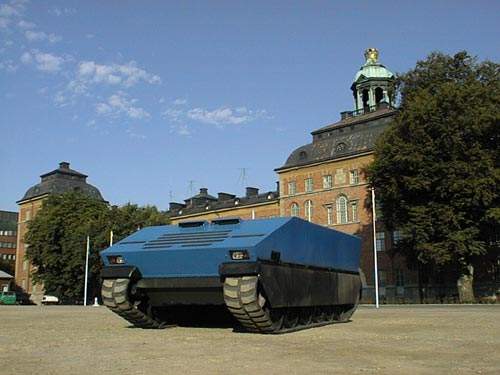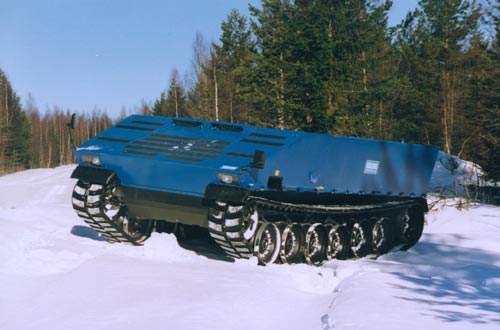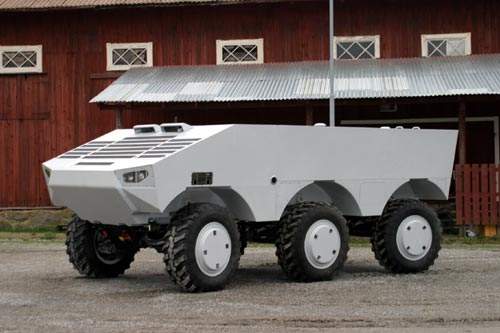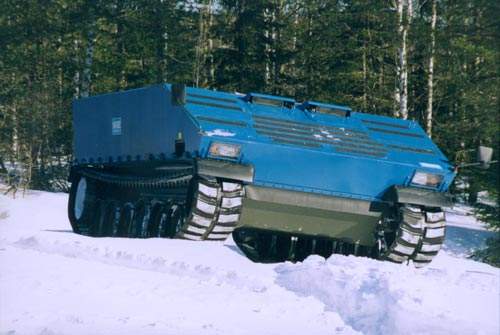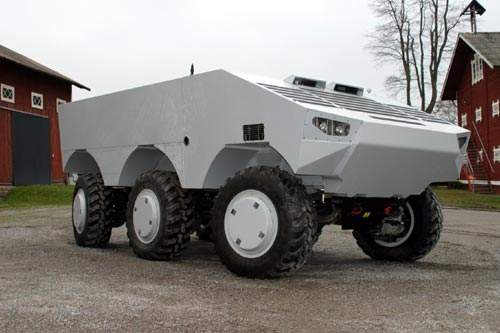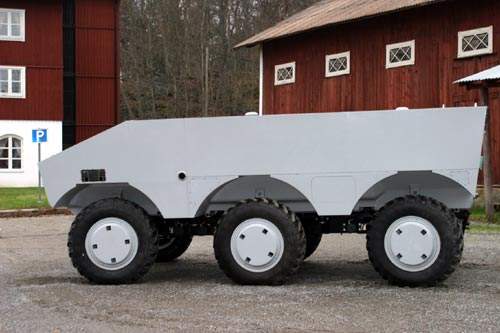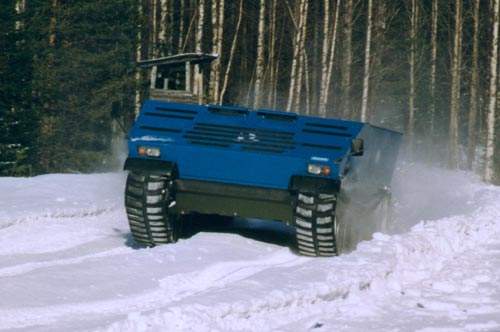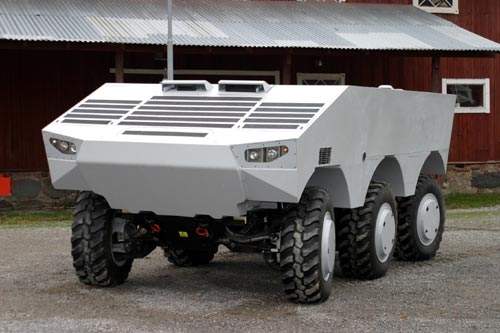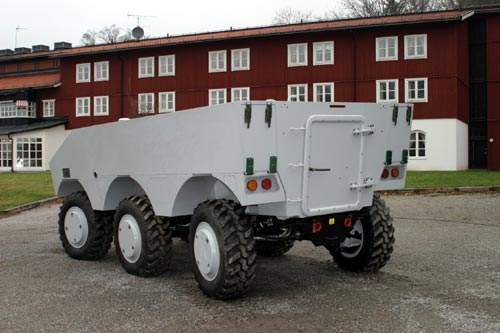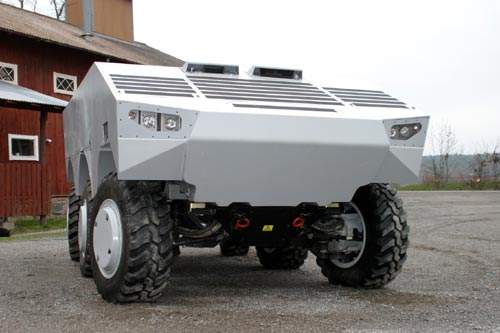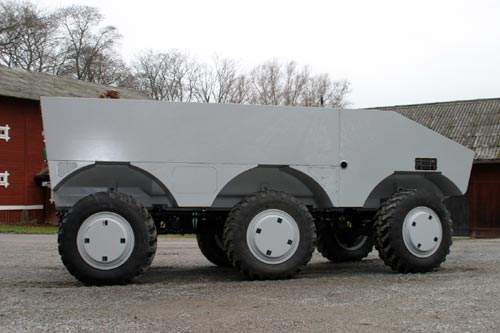BAE Systems Land Systems Hagglunds has developed the SEP (spitterskyddad enhets platform) modular armoured tactical system which incorporates an electric transmission system and a family of demountable interchangeable mission modules.
The electric transmission system (the drive shafts have been replaced by cable and the power from the engines is transferred by cable) gives a number of advantages, including volume efficiency, fuel efficiency, reduced life cycle costs, reduced environmental impact and increased stealth characteristics.
The engine is decoupled from the final drives allowing flexibility in the placing of systems in the vehicle and also easily allows two engines to be installed instead of one. Batteries are integrated into the electric drive system, which allow the vehicle to be driven silently for several hours with the engines shut down.
The useable internal volume of 8.7m³ is a substantial increase over a conventionally powered vehicle of a similar length. The SEP combat weight is 13.5t and the load capacity is up to 6t.
The top speeds for the wheeled and tracked variants are 100km/h and 85km/h respectively.
SEP modular armoured vehicle programme
Development work on the SEP began in 1996. The first SEP-track demonstrator was delivered to the Swedish defence material administration Forsvarets Materialverk (FMV) in November 2000 for trials and evaluation and by 2003 the vehicle had covered over 2,000km in various trials.
FMV placed a contract on Hagglunds for the development of the wheeled version of SEP in November 2001 and a wheeled 6×6 variant prototype demonstrator, SEP-wheel, was delivered to FMV in 2003. In 2003, FMV placed a risk reduction contract on Alvis Hagglunds (now BAE Systems, Land Systems Hagglunds) involving the construction of a second tracked SEP testbed vehicle. This vehicle was rolled out in November 2005.
A contract for final development was placed by the FMV in July 2006. A further two tracked and two 6×6 wheeled vehicles were to be built under the contract. An 8×8 wheeled SEP demonstrator was rolled out in February 2007. SEP was planned to enter service in 2014.
SEP programme cancellation
In February 2008, the Swedish Armed Forces announced the cancellation of the SEP programme. The reasons stated were a ‘lack of an international collaborative partner’ which did not allow the armed forces to continue the project alone. Contracts will therefore not be placed for the next stage of SEP development. BAE Systems is completing the build of four pre-production vehicles (two tracked, two wheeled).
BAE Systems may offer a version of the SEP vehicle, named Thor, for the US Marine Corps Marine Personnel Carrier (MPC) requirement. Thor was trialled in the Nevada desert in 2007.
In a parallel programme, Land Systems Hagglunds is also coordinating the industrial efforts of a six-nation, all-electric vehicle project with the participation of Finland, Holland, Italy, Greece, Sweden and Turkey.
In January 2006, BAE Systems was awarded one of the UK Army’s future rapid effect system (FRES) chassis concept (CC) technology demonstration programme (TDP) contracts.
The BAE Systems chassis concept TDP was based on the SEP programme and addressed the suitability of the SEP electric drive system for the FRES missions. An 8×8 demonstrator vehicle, with mechanical rather than electric transmission, was completed. The vehicle was not downselected for the FRES trials programme in July 2007.
Stealth
The electric drive vehicle has greatly improved stealth characteristics in terms of thermal and acoustic signatures as well as low visual and radar signatures. The continuous rubber band tracks are much quieter and lighter than conventional steel tracks.
SEP-wheeled vehicle
The SEP-wheeled vehicle has three axles and is driven through all six wheels. The propulsion system is based on two engines with electric transmission. The integrated 100kW maximum power, permanent magnet type electric motors are supplied by magnetic systems technology (UK) and are located in the wheel hubs. The motors are fitted with a two-speed reduction gear.
The wheels are mounted with double cast-steel wishbones with a short torsion bar spring connected to the upper wishbones. The front wheels are steered normally, the centre wheels are not steered and the rear wheels are electronically controlled to provide steering at low to medium speeds and to cut out the rear wheel steering at high road speeds to maintain high-speed stability. The wheels are fitted with 405/70 type R24 tyres.
Tracked SEP
The tracked vehicles are fitted with rubber bandtracks rather than conventional steel link tracks. The bandtracks are lighter, quieter and have a longer operational life. The noise developed by the running gear is reduced by about 6dB. Bandtracks also have a lower rolling resistance. Band track technology has been used previously by Land Systems Hagglunds on the Bv206 articulated carriers which use short track length bandtracks.
In the SEP tracked vehicle the suspension is mounted on the underframe and not on the side frames, so the suspension is separated from the hull. A result of using a decoupled suspension and bandtracks is that the internal noise level is as low as 85dB which is sufficiently low to meet civilian vehicle noise requirements.
The decoupled suspension also provides a spaced outer layer which gives improved protection against mines. The SEP vehicle can withstand a 7kg TNT explosion under a track.
The company Ingenieurebureau Deisenroth (IBD), based in Germany, has developed a SEP protection kit that provides protection against advanced mines with explosively formed penetrators.
Missions
The modular design allows the vehicle to be configured for 24 different roles including: armoured personnel carrier, troop transport, command post, ambulance, anti-tank missile system, anti-aircraft missile system, mortar vehicle, forward observation, NBC (nuclear, biological and chemical) decontamination centre, and mine clearing and scattering.
The mission or role-specific modules can be fitted on both the SEP track and SEP wheel vehicle base units. Plug-in building blocks have been used, allowing fast adaptation and quick upgrades as new technologies become available.
The vehicles are capable of operation in a many different types of terrain and in a wide range of climatic conditions.
SEP command and control
The vehicle uses a new electronic architecture, VETEC, developed by Hagglunds, based on an open scalable, fault-tolerant databus which manages all the on-board systems and the crew interfaces including the weapons systems, battlefield management, defensive aids suite, built-in test, digital radio communications and other mission or role-specific systems.
Crew stations
The crew stations each occupy 0.35m³ of the available hull space. The crew stations and the SEP man-machine interface were developed under a collaborative venture by Alvis Hagglunds of Sweden and Diehl Gerate of Germany, which was sponsored by the Swedish FMV and the German Federal Office for Defence Technology and Procurement.
Self-protection
The different zones of the vehicle have different levels of ballistic protection, with the highest level of protection for the personnel compartment.
The hull is of high hardness steel armour construction rated to protect against shell fragments and rifle rounds. IBD of Germany has developed the SEP add-on armour.
The 1.5t add-on armour includes ceramic tiles and provides protection against 14.5mm armour piercing rounds. Heavier armour provides protection against 30mm armour piercing fin stabilised discarding sabot (APFSDS) rounds.
Engines
The SEP uses two commercially available diesel engines. The first B-13 tracked testbed vehicle is fitted with two five-cylinder, 2.3l Volkswagen car diesel engines rated at 130kW each. The engines are coupled to ZF generators and are installed in the front of the sponsons on both sides of the crew compartment.
The second B-13 tracked testbed is equipped with the Steyr M16 3.2l, six-cylinder Steyr M16 diesel engine, rated at 130kW, which is also installed on the armoured articulated Bv206S Hagglunds vehicle.
The final drives are connected by a cross-shaft which gives higher power efficiency in turning manoeuvres by transferring the power regenerated at the inner track during a turn to the outer track. The vehicle is fitted with a bandtrack developed and supplied by Soucy International in Canada.
In February 2009, BAE Systems announced a teaming agreement with Kongsberg Devotek of Norway to develop new gears and transmission for the SEP.

